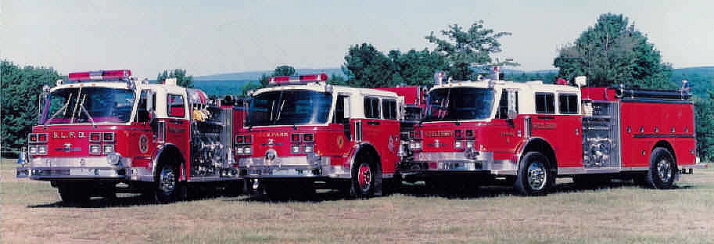| Welcome to the Century 2000 Pages The
second
incarnation of American LaFrance, the American LaFrance Century 2000
Series, and the entire Kersey production from 1986 to 1994.
|
News
UPDATES Nearly COMPLETE!
I have received numerous photos over the past few years of
ALF/Kersey apparatus. I have included these in some of the
individual apparatus pages. Some of these photos lack the
proper photographer credit. If you are one of those
photographers please email the webmaster for proper photo
credit. Thanks!!
Photos WANTED:
Rialto, CA Pacemakers; Laredo, TX Pacemakers; Pensacola,
FL C2000; El Paso, TX Water Chiefs, Winfield Community, MD
C2000, Ckeektowaga (Cleveland Hill), NY Patriot.
|
The Birth of the Century 2000 Series began
with the closing of American LaFrance's production at the
Southport, NY facility, a suburb of Elmira at the end of 1985.
In early 1986, some parts, a cab/chassis/body combo and ALF
personnel were sent to a Figgie facility in Bluefield, Virginia,
the Kersey Manufacturing Company. There, in a plant that
produced aircraft towing tractors and mining equipment, fire
apparatus would soon be the center of attention. Production of
fire apparatus would continue there for nearly a decade before
it too met the same fate as the Southport plant.
During the Kersey/American LaFrance years
many different models and styles of apparatus were produced
there. Most notably the Century 2000, but also, the Pacemaker,
Century, Century low-boy, Patriot and several others, in all
151 pieces of custom fire apparatus were built.
Kersey/ALF Promotional Material click
HERE
| I am indebted to the many
individuals who have contributed multiple photographs to this work.
My sincere thanks goes out to Scott Fralic, Dave Organ, Mike
Martinelli, Ron Bogardus, John Kenealy, Mike Murphy, George Murphy,
Mike Kosydar, Richard Story, Mark Redman, Neal Van Deusen, and many others. All known photo
credits are on individual pages- please don't feel slighted if I
failed to mention your name here- the photo is greatly appreciated.
If you have a photo of any of the apparatus produced at the
ALF/Kersey plant or refurbed at any of the Service Centers please
forward it to the webmaster so that it may be included in our
apparatus pages.
|
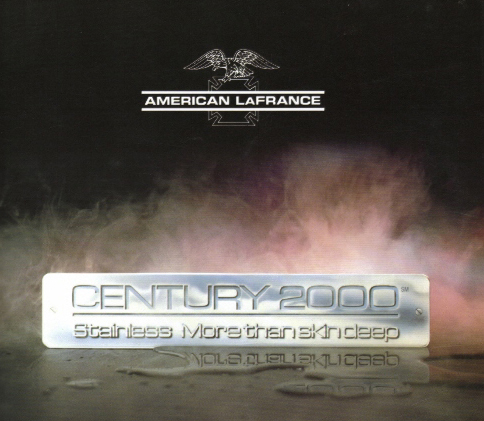
The First Century 2000 thru
the lens of Jack Greible
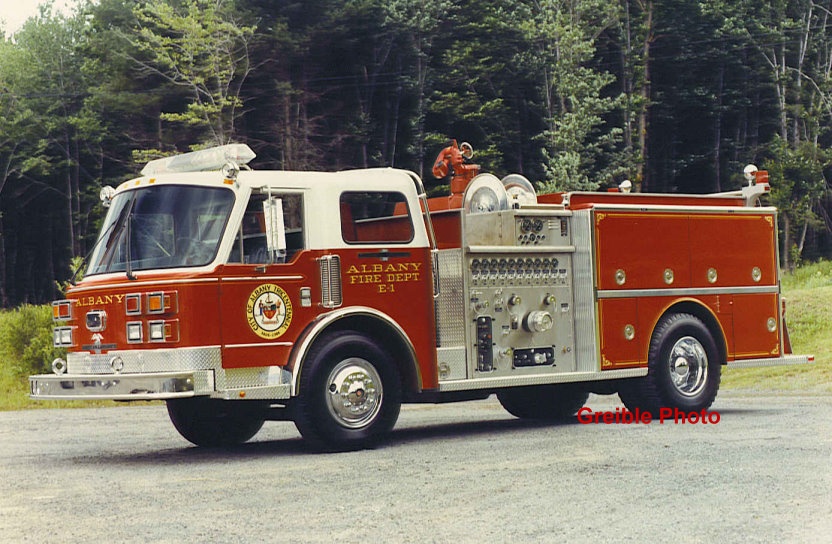
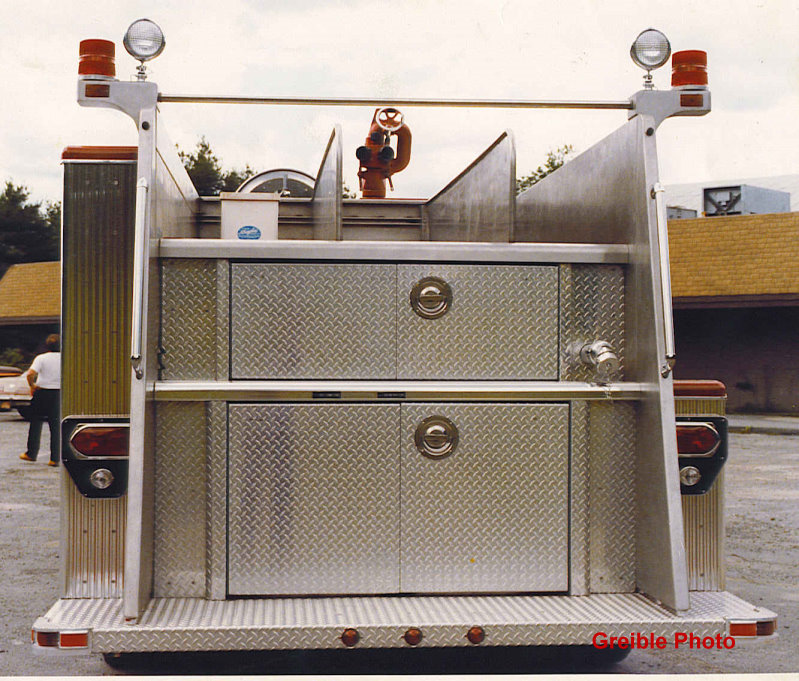
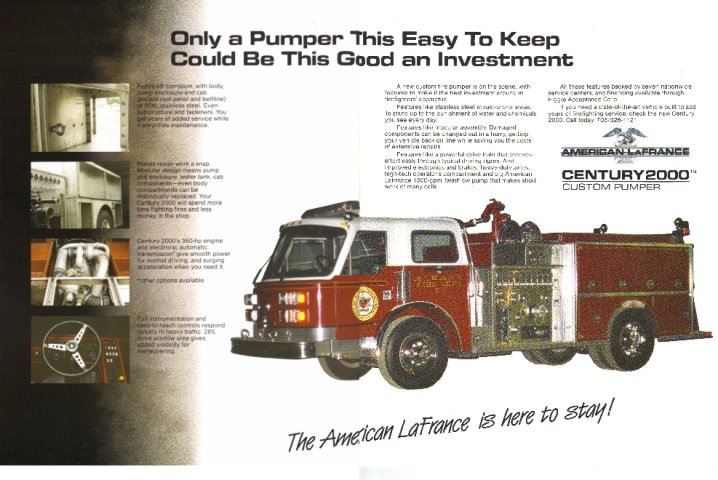
|
|

The Phoenix Volume II, Number 4
December 1987
The "Bar & Bird" logo has been around since 1970
as the American LaFrance emblem. The bar with the cross
was designed by Ron Tappan in 1965, and it was Ron who added the
eagle too.
Almost every organization has an emblem of some
sort, and these stem from the days of heraldry. Those were the
days when the emblem of a man carried on his shield or helmet,
told friend and foe about himself and his heritage. It let the
world know his identity, without his ever having to say a word.
A form of cross was adopted by the Fire Service, probably in the
mid-1800's as one of the most distinctive emblems.
Although crosses were used by other religions too, the cross
owes its place in heraldry as the accepted symbol of
Christianity. In Christian art it represents the passion of
Christ and His Church. To firemen, the cross was symbolic of
both protecting and being protected. It was accepted by both
Roman Catholics and Protestants. Christ and God were to them in
their duties, and this idea was important to their survival, and
their efforts to help others survive. If their success was not
ordained, then the cross, and their religion, was their solace.
The cross was often the symbol of a knight, and I doubt that a
better description of a fireman could be found.
In heraldry, there are many versions of the cross. What we are
primarily interested in, though, is the cross patée, sometimes
spelled pattée, with two ts. The second word is pronounced patā
(like the stuff made with goose livers.) The cross pattée was
the distinguishing badge of the Knights Templar. It is a cross
with four limbs which expand to the extremities and whose outer
edges are flat.
The Fire Service cross is similar, but with a bulge on the outer
edges.
The four limbs of the Maltese cross, the badge of the Knights of
Malta, expand and terminate in eight points. These points are
said to be symbolic of the Beatitudes. As can be seen, the
Maltese cross bears only superficial resemblance to the cross
pattée.
Next, we have an addition to the cross pattée and the Fire
Service cross. That is the adding of a circle at the center.
This does not allow the limbs of the cross to form a “V” where
they meet at the center. The rounded projections between the
arms, caused by the circle, makes the cross a cross nowy,
(pronounced “nou-i” or now-i”.) This makes the whole thing a
cross pattée nowy.
The Fire Service cross does not fit exactly into any category
that my research material can supply, because of the bumps on
the limbs. It may be, as mentioned before, a cross convex, or it
may be a cross pattée nowy, nowyed. The term nowyed means the
cross has small convex projections, but elsewhere but at the
middle.
Finally, we get to the cross that has been used by American
LaFrance and its ancestors since 1891. This cross is a cross
pattée nowy, and became the Company’s emblem when Button, Silby,
Ahrens and Clapp & Jones joined to form the American Fire Engine
Company. As can be seen in the 1892 version, each arm symbolizes
one of the four founding companies, with the circle bringing
them together as the American Fire Engine Company.
Various forms of this emblem have been used over the years,
although it did disappear occasionally. Best know to most of us
is what is fondly know as the “bar and the bird.” The cross is
ignored in the terms, but it is still there.
I realize that you are still going to call it a Maltese cross,
but now you have a bit of knowledge to confound your friends.
John M. Peckham
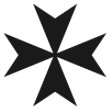
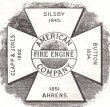
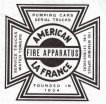
|
|
|
|
